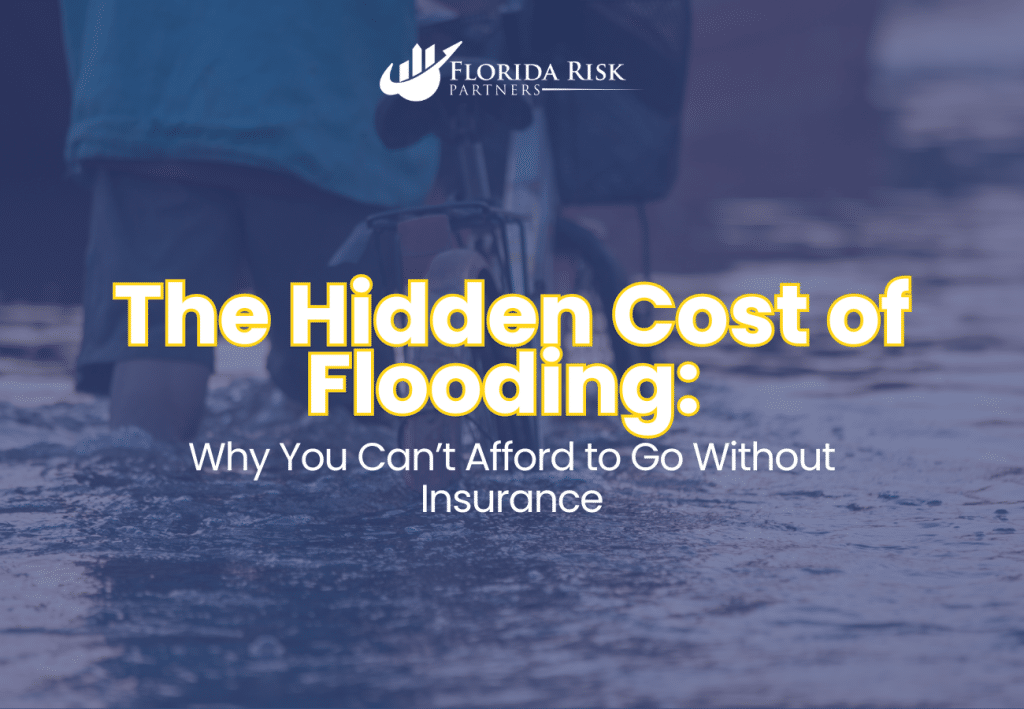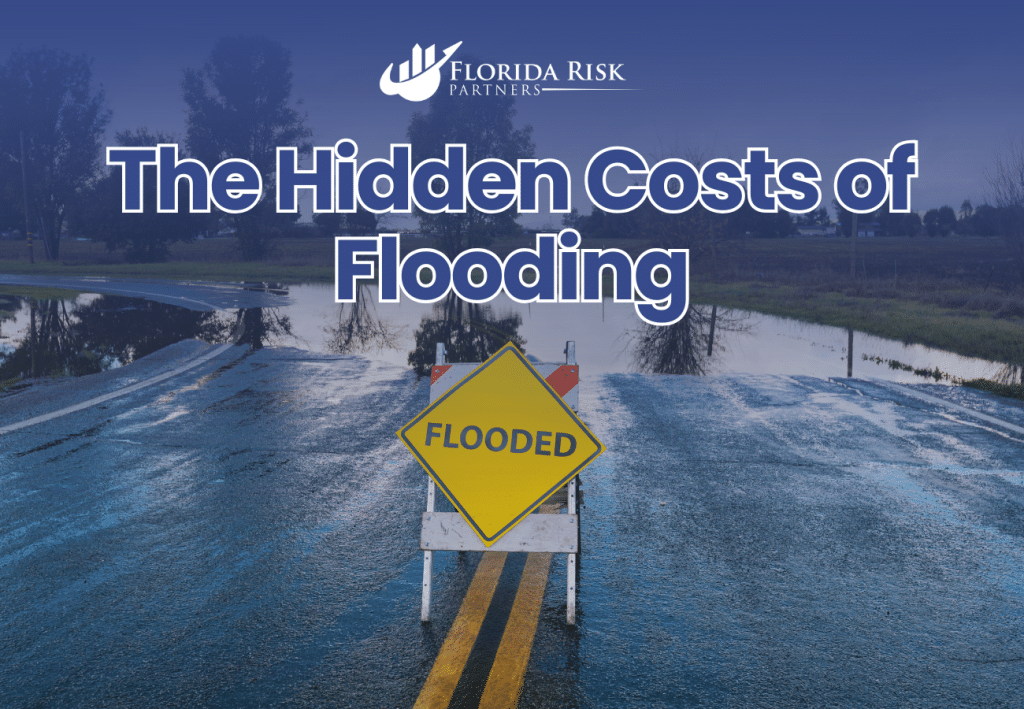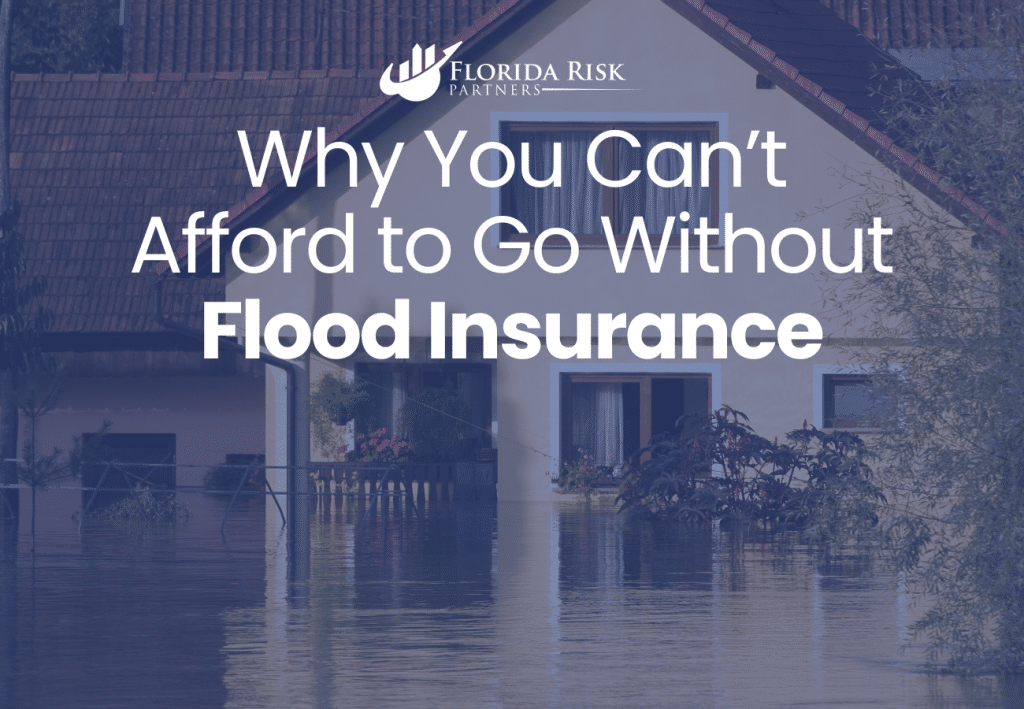-
Main Office: 1434 E. Bloomingdale Ave Valrico, FL 33596-6110
-
Phone: (888) 601-6660
-
Email: info@floridariskpartners.com

Flooding is one of the most destructive and costly natural disasters in the United States. While most people are aware of the immediate damage that flooding can cause, many fail to account for the hidden costs that come with recovering from a flood. Whether you live in a high-risk flood zone or an area that has never experienced a major flood, the financial toll of flooding can be devastating—and without flood insurance, you could find yourself paying for it out of pocket.
In this post, we’ll break down the hidden costs of flooding, explain why flood insurance is essential for homeowners and business owners, and provide insights into how flood insurance can help you protect your property and finances. This post is part of our Flood Insurance 101 series, where we provide comprehensive information to help you make informed decisions about flood insurance and its importance.
The Immediate Costs of Flooding
The most obvious cost of flooding is the damage to your property. Floodwaters can cause structural damage to your home or business, destroy personal belongings, and even make the building uninhabitable. According to the Federal Emergency Management Agency (FEMA), just 1 inch of floodwater can cause more than $25,000 in damage to a home.
For businesses, the damage can be even more extensive. Flooding can destroy inventory, equipment, and essential systems, leading to significant downtime and lost revenue. The immediate costs of flood damage include:
- Structural damage to walls, floors, and foundations
- Damage to electrical and plumbing systems
- Ruined appliances and fixtures
- Loss of personal belongings such as furniture, electronics, and clothing
- Destroyed business inventory and equipment
Without flood insurance, all of these costs fall on you. Most homeowners and business property insurance policies do not cover flood damage, meaning you would be responsible for paying for repairs and replacements out of pocket. Learn more about what homeowners insurance covers here.
The Hidden Costs of Flooding
Beyond the obvious damage to your property, flooding brings with it a host of hidden costs that can continue to affect you long after the water has receded. These hidden costs can significantly increase the financial burden of recovering from a flood.
1. Temporary Housing and Relocation Costs
If your home or business is uninhabitable after a flood, you may need to find temporary housing or relocate your business operations. This could mean staying in a hotel for an extended period, renting a temporary office space, or even moving in with family or friends. The cost of temporary housing can add up quickly, especially if your home takes months to repair.
For business owners, relocation costs may include renting new office space, paying for moving services, and covering the cost of business interruption. Business interruption coverage is typically not included in standard flood insurance policies but may be available through private flood insurance providers.

2. Mold and Mildew Remediation
Mold and mildew can begin to grow within 24 to 48 hours after a flood, and removing it can be both time-consuming and expensive. If not properly addressed, mold can cause long-term health problems and lead to further damage to your property. Mold remediation often requires professional services, which can cost thousands of dollars depending on the severity of the infestation.
If you don’t have flood insurance, you’ll be responsible for paying for mold remediation out of pocket. Even with insurance, you’ll need to act quickly to prevent mold growth from becoming a major problem. Learn more about flood insurance coverage options here to see how it can protect your property from these hidden costs.
3. Loss of Business Income
For business owners, the financial impact of flooding goes beyond the cost of repairing the physical damage. Flooding can force your business to close for weeks or even months, resulting in lost income during that time. Without the ability to serve customers, generate revenue, or produce goods, your business could face significant financial strain.
Some private flood insurance policies offer business interruption coverage, which helps cover lost income during the recovery period. However, standard NFIP policies do not include this coverage, making it essential for business owners to explore additional insurance options. Compare private flood insurance options here to see if this coverage is right for your business.
4. Health and Safety Risks
Floodwater is often contaminated with bacteria, chemicals, and other hazardous materials, which can pose serious health risks to those living or working in a flooded property. Even after the water has receded, lingering contaminants can cause respiratory issues, infections, and other health problems. Addressing these health and safety risks may require additional cleanup and remediation efforts, which can increase the overall cost of recovery.
In some cases, structural damage caused by flooding can also create safety hazards, such as weakened foundations or electrical systems. Ensuring that your home or business is safe to re-enter and occupy may require professional inspections and repairs, further adding to the hidden costs of flooding.
Why You Can’t Afford to Go Without Flood Insurance
Given the immediate and hidden costs of flooding, it’s clear that flood insurance is essential for protecting your finances. While some homeowners and business owners assume that they don’t need flood insurance because they live in low-risk areas, the truth is that flooding can happen anywhere.
In fact, more than 20% of flood insurance claims come from properties located outside of high-risk flood zones. Even if you’ve never experienced a flood before, changing weather patterns, new construction projects, and other factors can increase your risk of flooding in the future. Without flood insurance, you could be left with tens of thousands of dollars in out-of-pocket costs if your property is damaged by a flood.

Affordable Protection for Your Home
Flood insurance provides an affordable way to protect your home from the financial impact of flooding. In moderate- to low-risk areas, flood insurance premiums can be as low as $400 to $700 per year, depending on the coverage limits and deductibles you choose. This is a small price to pay compared to the potential cost of repairing flood damage without insurance.
Even if you live in a high-risk area, there are steps you can take to reduce your premiums, such as elevating your home or investing in flood mitigation measures. Calculate your flood insurance premium here to see how affordable flood insurance can be for your property.
Critical Coverage for Business Owners
For business owners, flood insurance is even more critical. Without the proper coverage, a flood could force you to close your doors permanently. The cost of repairing damage, replacing equipment, and relocating operations can be overwhelming, especially when combined with lost income during the recovery period.
By purchasing flood insurance, you’re protecting not only your physical assets but also your ability to keep your business running after a disaster. Private flood insurance policies can offer higher coverage limits and additional protection for business interruption, ensuring that you have the resources you need to recover.
How to Buy Flood Insurance
If you don’t already have flood insurance, now is the time to act. The process of buying flood insurance is straightforward, but it’s important to understand your options and choose the right coverage for your needs.
- NFIP Flood Insurance: The National Flood Insurance Program (NFIP) offers standardized flood insurance policies for homeowners, renters, and business owners. Coverage is capped at $250,000 for residential buildings and $500,000 for commercial buildings, with additional coverage for contents.
- Private Flood Insurance: For those who need higher coverage limits or additional protection, such as business interruption insurance, private flood insurance is available. Private insurers often offer more flexible coverage options and may provide better rates depending on your location and risk level.
To get started, check your flood zone here and compare quotes from both the NFIP and private insurers. Remember, most flood insurance policies have a 30-day waiting period before coverage takes effect, so don’t wait until the next storm is on the horizon to secure your policy.
Conclusion: Protect Yourself from the Hidden Costs of Flooding
The hidden costs of flooding can be just as devastating as the immediate damage to your property. From temporary housing expenses to mold remediation and lost business income, the financial impact of a flood can quickly spiral out of control if you don’t have flood insurance.
Whether you live in a high-risk flood zone or a low-risk area, flood insurance is an essential tool for protecting your home or business. Don’t leave yourself vulnerable to the financial burden of a flood—get your flood insurance quote now here and ensure you’re fully covered before disaster strikes.
Call Us Or
Schedule an Appointment
Select an agent below to view our online calendars and select a day and time that works best for you or call us directly at 888-601-6660. When you use our online calendars, you will receive an email with more information.



